|
Image. CNN Report: “Chinese Cops” in Tibet: Footage of a protest movement in India, 2008
While Google and Facebook relentlessly target the independent online media in their campaign against “Fake News”, the routine use of fake videos and images by the mainstream media, is not an object of concern.
It has become routine for the mainstream media including network TV to present fake images and footage of protest movements.
This process of manipulating the truth and presenting fake images is nothing new. When it is discovered, CNN or the BBC will invariably apologize for having used the “wrong image”, from the “wrong country” from its extensive archives.
The February 2014 anti-government riots in Venezuela were “documented” by numerous fake images.
“Here are some brutal cops, with nice woolly caps and fur collars to guard against the 24°C Caracas weather, I assume.”
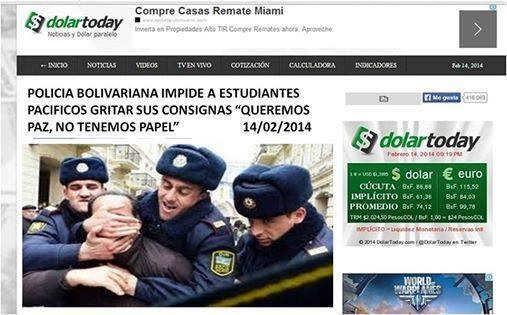
Below:
“This one is so iconic! But CNN had to admit that the graphic photo depicting a Venezuelan cop threatening a protester was actually taken in Singapore. See Constructing the Deception of the Anti-Government “Protests” in Venezuela: A Photo Gallery, Global Research, 18 February 2014
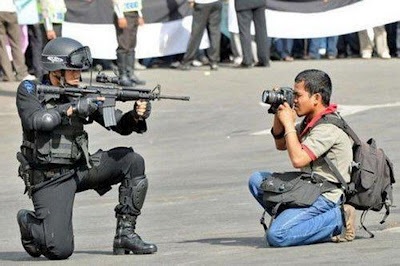
Green Square Tripoli, 2011.
Libyans are seen celebrating the victory of Rebel forces over Gaddafi in this 2011 BBC News Report (see below)
–
Examine the footage: It’s not Green Square and it’s not the King Idris Flag (red, black green) of the Rebels.
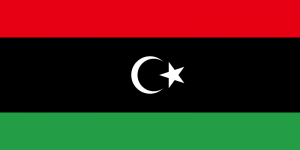
Its the Indian flag (orange, white and green) and the people at the rally are Indians.
Perhaps you did not even notice it.
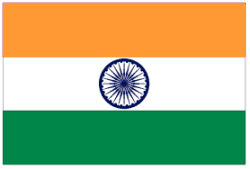
And if you did notice, ”it was probably a mistake”, according to the BBC: “we’re so sorry, got it mixed up”
The Tibet 2008 Riots
Scroll down for complete report.
Alleged Chinese cops in khaki uniforms are shown repressing Tibet demonstrators in China.
CNN, March 14, 2008 1′.36”

But the cops are not Chinese. They are Indian.
Khaki colored uniforms were first introduced in the British cavalry in India in 1846.
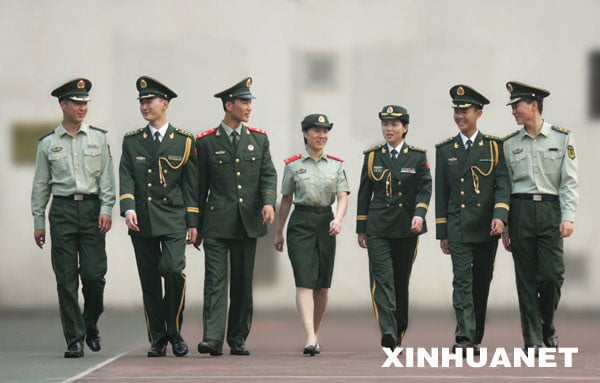
No khaki uniforms in China. These are the uniforms of China’s “Armed Police”.
Most people who viewed the CNN report failed to notice that these Chinese cops with khaki uniforms and mustache do not look Chinese.
I think the issue is that most viewers trust CNN. They would not –by any stretch of the imagination– accept the fact that CNN is quite deliberately falsifying the news using fake video footage.
Think Twice.
CNN has got its countries mixed up. Sloppy journalism or media fraud?
The following text written in April 2008 shows how CNN reported on the Tibet riots by using footage of a protest movement which occurred in the Indian state of Himachal Pradesh.
And then they accuse the independent online media including Global Research of “fake news”.
Michel Chossudovsky, Global Research, February 22, 2014, updated, August 10, 2015
Western Media Fabrications regarding the Tibet Riots
by Michel Chossudovsky
Global Research, April 16, 2008
On the day of the Lhasa Riots (March 14, 2008), there is evidence of media fabrication by CNN.
The videotape presented by CNN in its News Report on the 14th of March (1.00pm EST) was manipulated.
VIDEO: Tibet monks protest against Chinese rulers (CNN, March 14, 2008)
The report presented by CNN’s Beijing Correspondent John Vause focused on the Tibet protests in Gansu province and in the Tibetan capital Lhasa.
What was shown, however, was a videotape of the Tibet protest movement in India.
Viewers were led to believe that the protests were in China and that the Indian police shown in the videotape were Chinese cops.
At the outset of the report, a few still pictures were presented followed by a videotape showing police repressing and arresting demonstrators in what appeared to be a peaceful protest:
“CNN received these photographs from Gansu province, where there is a large Tibetan population”
JOHN VAUSE, CNN CORRESPONDENT
[CNN Vause reports on the protest movement in Gansu province. (starts at 1′.00)]
CNN received these photographs from Gansu province, where there is a large Tibetan population. [still photographs followed by video footage] According to Students for a Free Tibet, about 2,000 protestors took to the streets earlier today. They were there for about three hours. They flew the Tibetan flag and called for an independent Tibet. All of this comes after days of unrest in Tibet after monks, who were marking the 49th anniversary of a failed uprising against Chinese rule.(CNN News, 1.00pm EST, March 14, 2008)
The voice over of John Vause then shifts into reporting on violence in Lhasa. The videotape however depicts the Tibetan protest in Himashal Pradesh, India.
[JOHN VAUSE, CNN CORRESPONDENT]
And what could be worrying here to Beijing is that these demonstrations are being joined by ordinary Tibetan civilians, lay Tibetans. The targets here are ethnic Chinese. We’ve been told by one Chinese woman that she was attacked by Tibetan rioters. Her injuries sent her to hospital.
Also under fire here, Chinese-owned businesses, as well as government offices, and also the security forces.
According to U.S.-based human rights groups, the three main monasteries on the outskirts of Lhasa have now been surrounded by Chinese troops, and they’ve been sealed off.
We’ve also heard over the last couple of days, according to human rights groups, that more than a dozen monks have been rounded up and arrested. And there are reports, unconfirmed, that at least two people have been killed.
Chinese Cops in Khaki Uniforms
The video footage, which accompanied CNN’s John Vause’s report, had nothing to do with China. The police were not Chinese, but Indian cops in khaki uniforms from the Northeastern State of Himachal Pradesh, India.
Viewers were led to believe that demonstrations inside China were peaceful and that people were being arrested by Chinese cops.
1′.27-1′.44″ video footage of “Chinese cops” and demonstrators including Buddhist monks. Chinese cops are shown next to Tibetan monks
Are these Chinese Cops from Gansu Province or Lhasa, the Tibetan capital, as suggested by CNN’s John Vause’s Report?
REPORT ON CHINA, MARCH 14

Alleged Chinese cops repressing Tibet demonstrators in China , CNN, March 14, 2008 1′.36”

Alleged Chinese cops in khaki uniforms repressing Tibet demonstrators in China, CNN, March 14, 2008 1’40”
Their khaki uniforms with berets seem to bear the imprint of the British colonial period.
Khaki colored uniforms were first introduced in the British cavalry in India in 1846.
Khaki means “dust” in Hindi and Persian.
Moreover, the cops with khaki uniforms and mustache do not look Chinese.
Look carefully.
They are Indian cops.
The videotape shown on March 14 by CNN is not from China (Gansu Province or Lhasa, Tibet’s Capital). The video was taken in the State of Himachal Pradesh, India. The videotape of the Tibet protest movement in India was used in the CNN report on the Tibet protest movement within China.
In a March 13 Report by CNN, demonstrators are being arrested by Indian police in khaki uniforms during a protest march at Dehra, about 50 km from Dharamsala in the northern state of Himachal Pradesh.
VIDEO; Tibet Protest movement in India, CNN, March 13, 2008
“Indian police arrested around 100 Tibetans on Thursday, dragging them into waiting police vans, as they tried to march to the Chinese border to press claims for independence and protest the Beijing Olympics.” (REUTERS/Abhishek Madhukar (INDIA))
Below are images from CNN’s report on March 13, on the protest movement in Himachal Pradesh, India:
Compare these images to those in the March 14 CNN report. Same cops, same uniforms, same Indian style mustache
CNN MARCH 13 REPORT ON INDIA
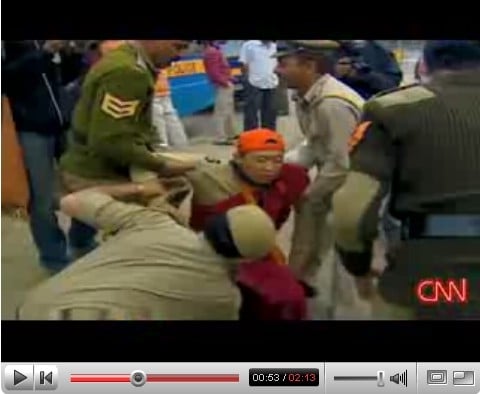
Indian cops repressing Tibet demonstrators in Himachal Pradesh, India CNN, March 13, 2008 0′.53″
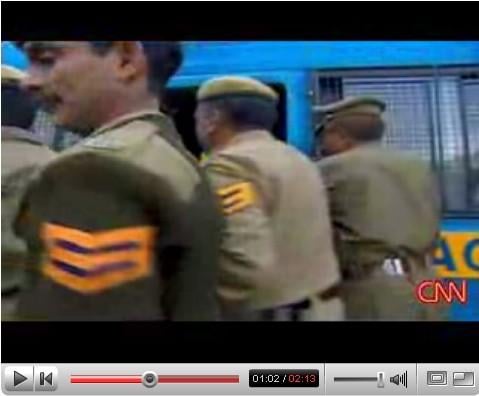
Indian cops repressing Tibet demonstrators in Himachal Pradesh, India CNN, March 13, 2008 1′.02″
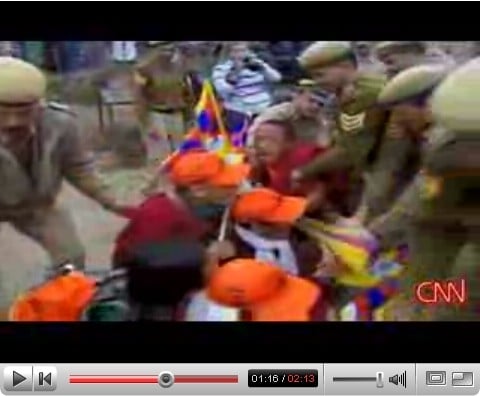
Indian cops repressing Tibet demonstrators in Himachal Pradesh, India CNN, March 13, 2008, 1′.18″
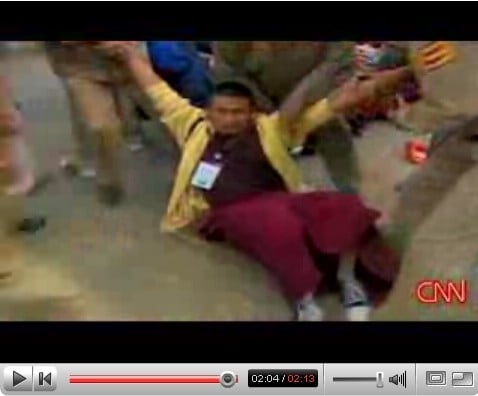
Indian cops repressing Tibet demonstrators in Himachal Pradesh, India CNN, March 13, 2008 2.04″
We invite our readers to examine these two reports as well as the Transcript of the March 14 CNN program.
The CNN’s March 14 report on the Tibet Protest movement in China shows Chinese cops in khaki uniforms, yellow lapels and berets. While the videotape is not identical to that of March 13, CNN’s coverage of the events in China on March 14 used a videotape taken from the coverage of the Tibet Protest movement in India, with Indian cops in khaki uniforms.
The video footage was not provided to CNN by a third party. It was part of CNN’s videotaping of the protest movement in Dharamsala on March 13.
The protest movement in India on March 13 was “peaceful”. It was organised by the Dalai Lama’s “government in exile”. It took place within 50 km of the headquarters of the Dalai Lama in Dharamsala.
The Western media was invited in to film the event, and take pictures of Buddhist monks involved in a peaceful, nonviolent march. These are the pictures which circled the World.
So what has occurred is that CNN has copied and pasted its own videotape of the Tibet Protest movement in India and has fabricated a Gansu Province/ Lhasa, China “peaceful” protest movement with Chinese cops in khaki British colonial style uniforms.
The Chinese never adopted the British style khaki uniform and beret.
These uniforms do not correspond to those used by the police in China. (See photograph below)

No khaki uniforms in China. These are the uniforms of China’s “Armed Police”.
Meanwhile, the images of the violent riots in Lhasa, in which a criminal mob set fire to shops, homes and schools, burning several people alive, and stabbing innocent civilians with knives were not shown on network TV in the US and Western Europe. Small segments of the riots in Lhasa were shown out of context and with a view to accusing the Chinese authorities of repressing a “peaceful protest”.(See our report on the events, see coverage of the Lhasa Riots by China’s CC-TV)
While the videotape used is not identical, both CNN reports, however, show the same cops in khaki uniforms and the same Tibetan demonstrators in India. The footage used in support of CNN’s March 14 coverage of the protext movement in China has nothing to do with China. it happened in India.
CNN has got its countries mixed up.
Sloppy journalism or media fraud?
VIDEO: Tibet monks protest against Chinese rulers (CNN, March 14, 2008)
VIDEO; Tibet Protest movement in India, (CNN, March 13, 2008)
COMPLETE TRANSCRIPT OF CNN NEWS COVERAGE ON TIBET (MARCH 14, 2008
CNN NEWSROOM 1:00 PM EST
March 14, 2008 Friday
[with Don Lemon and John Vause reporting from Beijing]
….
LEMON: All right. So this place, we know, should be known for peace. Right? But that is not what is happening here lately.
Buddhist monks demonstrating for independence from China. Ethnic Tibetans join in, and soon — soon streets are filled with screams, with gunfire, with rioting. And so far the Chinese government has refused to allow CNN to even enter Tibet.
Our John Vause brings us what he knows. He’s in Beijing.
(BEGIN VIDEOTAPE)
JOHN VAUSE, CNN CORRESPONDENT: The latest information from our sources in Lhasa tell us that the streets are basically deserted, except for patrols by police cars and armored military vehicles.
We’re told fires are still burning and phone lines are still down, but electricity has been restored. And the situation there now is described as relatively calm. But these protests do appear to be spreading to the east of the country.
CNN received these photographs from Gansu province [still picture followed by live video of Indian protest], where there is a large Tibetan population. According to Students for a Free Tibet, about 2,000 protestors took to the streets earlier today. They were there for about three hours. They flew the Tibetan flag and called for an independent Tibet. All of this comes after days of unrest in Tibet after monks, who were marking the 49th anniversary of a failed uprising against Chinese rule.
And what could be worrying here to Beijing is that these demonstrations are being joined by ordinary Tibetan civilians, lay Tibetans. The targets here are ethnic Chinese. We’ve been told by one Chinese woman that she was attacked by Tibetan rioters. Her injuries sent her to hospital.
Also under fire here, Chinese-owned businesses, as well as government offices, and also the security forces.
According to U.S.-based human rights groups, the three main monasteries on the outskirts of Lhasa have now been surrounded by Chinese troops, and they’ve been sealed off.
We’ve also heard over the last couple of days, according to human rights groups, that more than a dozen monks have been rounded up and arrested. And there are reports, unconfirmed, that at least two people have been killed.
Beijing has now moved to seal off Tibet, banning foreigners and journalists from traveling there. Flights and train services have also been canceled.
John Vause, CNN, Beijing.
(END VIDEOTAPE)
This is not the only example of media fabrication where video images and photographs are manipulated.
What really happened.
Compare CNN’s report using a fake videotape to the coverage of the Lhasa riots on China State TV.
coverage of the Lhasa Riots by China State Television CC-TV
Who is Telling the Truth?
Michel Chossudovsky is Director of the Centre for Research on Globalization (CRG). He is the author of several international best-sellers including The Globalization of Poverty and the New World Order, Global Research, 2003 and America’s “War on Terrorism”, Global Research, 2005. He is a contributor to the Encyclopedia Britannica. His writings have been translated into more than 20 languages.
Michel Chossudovsky is also the author of the first comprehensive study on the restoration of capitalism in China, published more than twenty years ago. Michel Chossudovsky, Towards Capitalist Restoration. Chinese Socialism after Mao, Macmillian, London, 1986. He has recently returned from a visit to China. He was in Shanghai and Beijing in March 2008.
|